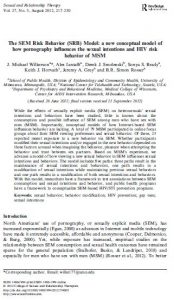Mental Health
The SEM Risk Behavior (SRB) Model
 Full Article Title: The SEM Risk Behavior (SRB) Model: A New Conceptual Model of How Pornography Influences the Sexual Intentions and HIV Risk Behavior of MSM
Full Article Title: The SEM Risk Behavior (SRB) Model: A New Conceptual Model of How Pornography Influences the Sexual Intentions and HIV Risk Behavior of MSM
Open Access: No
Abstract
While the effects of sexually explicit media (SEM) on heterosexuals’ sexual intentions and behaviors have been studied, little is known about the consumption and possible influence of SEM among men who have sex with men (MSM). Importantly, conceptual models of how Internet-based SEM influences behavior are lacking. A total of 79 MSM participated in online focus groups about their SEM viewing preferences and sexual behavior. Of these, 23 reported recent exposure to a new behavior via SEM. Whether participants modified their sexual intentions and/or engaged in the new behavior depended on three factors: arousal when imagining the behavior, pleasure when attempting the behavior and trust between sex partners. Based on MSM’s experience, we advance a model of how viewing a new sexual behavior in SEM influences sexual intentions and behaviors. The model includes five paths: three paths result in the maintenance of sexual intentions and behaviors, one path results in a modification of sexual intentions while maintaining previous sexual behaviors and one path results in a modification of both sexual intentions and behaviors. With this model, researchers have a framework to test associations between SEM consumption and sexual intentions and behavior, and public health programs have a framework to conceptualize SEM-based HIV/STI prevention programs.
